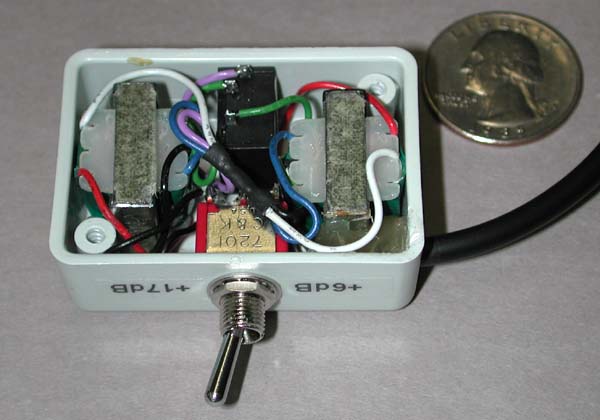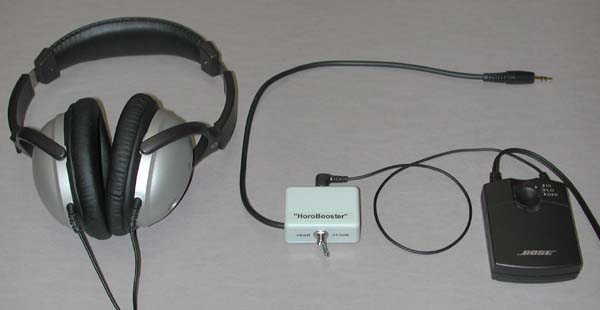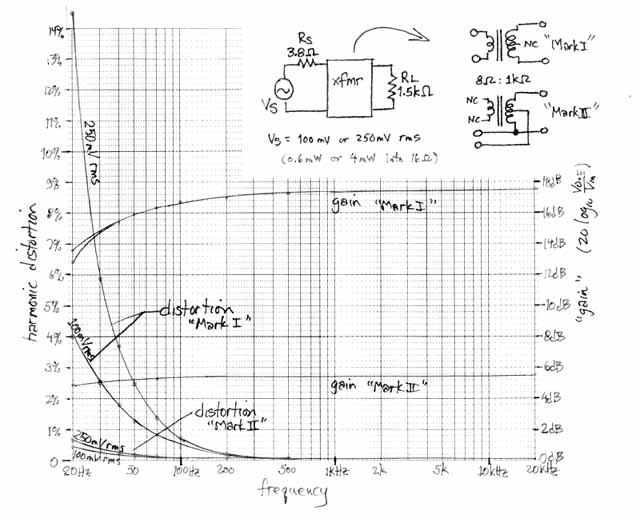"HoroBooster"
Bose's "Quiet Comfort" noise-cancelling headphones are terrific,
especially if you fly a lot. But various contemporary audio gizmos
provide too little output level -- for example the Sony NetMD 707.
As it turns out, the Bose phones are high input impedance (about 1.5k),
so you can boost the level without using any power, just by using
a small audio transformer with modest turns ratio.
Here's an illustrated tour:
The Inside
I used a pair of Radio Shack miniature audio transformers (273-1380),
rated at 8 ohms to 1k (center tapped). You put the phones across
the 1k winding, then drive the 8 ohm winding; or you can drive the
CT of the 1k winding. The switch selects which way you run it.
Using the 8 ohm winding as input you should get about 21 dB of "gain",
whereas using the 1k tapped winding as an autotransformer you
should get 6 dB of "gain" (there's no power gain, of course, just
a voltage stepup). In reality you get a bit less, roughly 17 dB and
5.5 dB respectively. I put the thing in a nice Hammond box, and used
a C&K DPDT toggle switch with contacts rated for dry switching of low
level signals.

The Outside
Here's how it looks on the outside; quite a bit smaller than the
headphones.

Perfromance?
Pretty darn good, considering the dimunitive transformers. In this
graph "Mark I" refers to the high-gain configuration (drive the 8 ohm
winding, headphones across the 1k winding), whereas "Mark II" is the
autotransformer configuration (drive CT of 1k secondary, ignore the
8 ohm winding altogether).

Obviously, gain comes at the expense of distortion and flatness: In
the low-gain (6 dB) configuration the thing is just plain flat from
100 Hz to 20 kHz, dropping about a half dB at 20 Hz; distortion is
negligible except at the low end, where it rises to about 0.25% at
40 Hz, and 0.5% at 20 Hz, for reasonably high player output levels.
In the high-gain (17 dB) configuration the falloff at low frequencies
is more serious, dropping 1 dB at 100 Hz, 2 dB at 50 Hz, and 4 dB at
20 Hz; distortion is much higher, reaching 1% around 60-80 Hz
(depending on level), and as much as 10% at 25 Hz at high output
levels.
Why is this? Well, an audio transformer is rated for some nominal
frequency range and impedance; they are designed so the magnetizing
inductance presents an impedance, at the low freq end of its intended
range, comparable to its nominal impedance (of each winding).
Thus, the "8 ohm" winding loads an 8 ohm source, reducing the output
(and, at high levels, risking core saturation) at the "low" freqency
end of its intended range. For these cheap tiny xfmrs, I found that
happens at about 100 Hz! That is why there is a dropoff below 100 Hz
in the high-gain configuration, and also distortion at low frequencies
that rises rapidly with signal level.
On the other hand, using the 1k winding alone, as an autotransformer,
improves the low end dramatically, because the magnetizing inductance
is higher by a factor of 60; it also reduces distortion to negligible
levels, because the magnetizing currents, even at low frequency, don't
take the core into saturation.
In actual use on airplanes, with the Sony NetMD as source, I find that
the low-gain setting is usually fine; only on pianissimo sections of
subtle classical music have I found it necessary to kick in the
afterburner. Even in the high-gain mode I haven't noticed distortion,
probably because the signal level at low frequencies is not terribly high,
and also maybe because it is so darned loud that one does not particularly
notice distortion.


